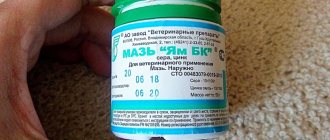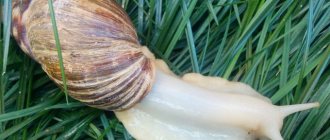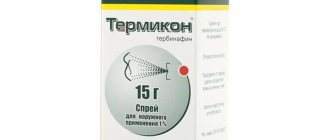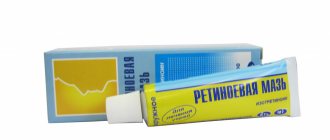Updated July 22, 2022 136 Author: Dmitry Petrov
Hello, dear readers of the KtoNaNovenkogo.ru blog.
Ichthyol ointment is one of the most time-tested medications.
It was this drug that saved hundreds of thousands of wounded soldiers during the war.
I’ll tell you about “ichthyolka” in more detail, “I’ll break everything down”: what the medicine is, what it consists of, what it helps with and how it’s used. Everything is as always: simple and accessible.
Ichthyol – antiseptic
Ichthyol (or ingammol
, or in chemical terminology -
ammonium bituminous sulfate
) is a resinous substance from shale rocks. It is a concentrate of organic substances with a large amount of sulfur. Ichthyol is obtained by multi-stage processing of organic resin found in sedimentary shale rocks.
Note: the name “ichthyol” is translated from Greek as “fish” or “fish oil”. This is due to the fact that skeletal remains of prehistoric fish are often found in shales.
In the production of ichthyol, shale resins are sublimated and distilled, after which they are treated with alkali, sulfuric acid and ammonia water, after which they are evaporated and a medicinal substance is obtained.
It was introduced into treatment practice at the end of the 19th century by the German physician Paul Unna. The medicine was given anti-inflammatory, antiseptic and analgesic effects
. It was intended for external therapy of skin and joint diseases, inflammations.
Today, ichthyol ointment is a traditional remedy for the treatment of purulent wounds . It is available in a concentration of 10%
.
Treatment with ichthyol ointment is used in dermatology, urology, gynecology and veterinary medicine. At the same time, the veterinary composition differs in concentration ( 20%
instead of
10%
).
Ichthyol ointment 20%
has a more pronounced effect. Therefore, sometimes patients use the veterinary composition for a quick therapeutic effect. Ichthyol contains a lot of organic sulfur. Therefore, its effect is similar to sulfur ointment (also antiseptic and anti-inflammatory).
The effect of ichthyol in ointment
Ichthyol ointment 10% is an effective drug for the treatment of skin and joint inflammation. How does the ointment work?
The active substance (ichthyol) inhibits the production of inflammatory mediators. In this regard, its effect is similar to the work of non-steroidal anti-inflammatory drugs, as a result of which joint pain is reduced and the development of inflammation is limited. In case of inflammation, ichthyol ointment acts as an analgesic - it reduces inflammation and reduces pain .
Ichthyol also slightly irritates the nerve endings, and this increases blood circulation and vascular tone in the area where the ointment is applied. As a result, the nutrition of tissues improves (in medical terminology, their trophism), the elimination of metabolic products is accelerated, and as a result, the area of inflammation decreases and the amount of pus (if any) decreases. Thanks to the tone of the vessels, their lumen narrows and the flow of fluid to the site of inflammation decreases. Which leads to a decrease in swelling.
Thus, ichthyol ointment draws out pus, treats inflammation on the skin (boils, dermatitis, post-burn redness) and in subcutaneous tissues (joints).
Treatment of inflammation has an effect on reducing pain. Therefore, ichthyol ointment is called not only an anti-inflammatory, but also an analgesic.
What is ichthyol ointment used for?
Ichthyol ointment in the instructions for use refers to antiseptic drugs. It exhibits a bactericidal effect primarily against gram-positive bacteria - Staphylococcus aureus, streptococcus . It also has some inhibitory effect against pathogenic fungi . Therefore, it is used to treat skin inflammations of bacterial and fungal origin, as well as joint pain.
Let's list what ichthyol ointment helps with and when it is used for external treatment:
- For skin infections (acne of various origins - boils, ulcers, acne, hidradenitis - purulent inflammation of the sweat glands in the armpits).
- For skin injuries (burns, frostbite) after primary epithelization.
Note: ichthyol ointment is not applied to an open wound. Therefore, it is not applied to open burn wounds, but is used after primary healing, the so-called primary epithelization.
- For allergic skin inflammations (eczema, dermatitis).
In gynecology, ichthyol ointment is used to treat inflammation (in the chest - mastitis, in the abdominal cavity - fallopian tubes, ovaries, uterus, as well as endometritis). In urology, ointment is used in the treatment of prostatitis.
Note: for inflammation of the pelvic organs, ichthyol rectal suppositories are used. They are introduced into the rectum, from where ichthyol is transported to the abdominal organs. This treatment is used in gynecological and urological practice.
In rheumatology, the ichthyol composition is used to reduce the area of inflammation in joint pain (arthritis, neuralgia of any origin).
Ichthyol ointment for boils and ulcers
The main property of ichthyol ointment is manifested as the ability to draw out purulent exudate. Ichthyol ointment for abscesses is used to accelerate the “ripening” of the boil (if abscesses have formed and are not in a hurry to ripen, they sit deep and hurt).
The use of ichthyol ointment for abscesses can speed up the process of abscess formation. It accelerates its tension and subsequent breakthrough. After which the pimple is carefully burned with alcohol .
Note: if the pimple is small, it may “disappear” without ripening. In this case, the pus from the ichthyol ointment simply resolves, and an abscess does not form.
Ichthyol ointment for acne
Ichthyol ointment helps improve the appearance of skin with purulent acne . She pulls out pustules from the deep subcutaneous layer. And this accelerates their maturation and treatment. How to use ichthyol ointment for cosmetic purposes?
- Acne removal - after pulling the pimple, if it has not opened on its own, it is squeezed out or pierced with a needle. Afterwards, the pus is removed and treated with an antiseptic. If necessary, apply ichthyol ointment again. When the pus has completely drained, epithelization (healing) of the skin tissue occurs.
- Cosmetic facial cleansing - ichthyol is applied to the face for 30-40 minutes. A mask of ichthyol ointment shows where inflammatory processes are still occurring and require repeated “cleaning”.
Note: in addition to the cosmetic “cleansing” procedure, in other cases it is not recommended to apply ichthyol ointment to the entire face. It is better to use it point-wise - exclusively on pimples, comedones, boils, and abscesses.
Ichthyol also draws out the contents of clogged sebaceous ducts (comedones).
- Removing blackheads - with oily skin, the sebaceous ducts are buried with the so-called “plug”. It creates the appearance of a black dot. An accumulation of blackheads on the nose, cheeks, cheekbones, and in the nasolabial triangle is called acne. Ichthyol dissolves sebaceous plugs and removes the contents of the duct out. Thus, the cosmetic effect of ichthyol ointment against blackheads is manifested.
- Ingrown hair treatment - uses the ability of ichthyol ointment to remove dirt and grease. Anti-acne agents are often used for therapy. They dissolve the sebaceous fat accumulated in the hair follicle. Thus, ichthyol ointment for ingrown hairs allows the hair to grow outward rather than inward.
- Treatment of chalazion - the ability of ichthyol to unclog sebaceous ducts is also in demand. This disease is associated with inflammation of the sebaceous gland on the eyelid, its blockage and the formation of a compaction or tumor. For chalazion, ichthyol ointment is applied from the outside next to the eyelid (so as to prevent it from coming into contact with the cornea of the eye). It pulls out the formed “barley” and treats inflammation.
Important: after a purulent formation breaks through, the rod must come out when treating a chalazion. Only then will the recovery be complete.
Does ichthyol ointment help with acne?
Ichthyol (ichthammol, ammonium bituminous sulfonate) is a substance obtained by dry pyrolysis (distillation) of bitumen shales. It is used to treat skin diseases, burns, and erysipelas.265
Ichthyol ointment can be used as an anti-inflammatory agent. It also shows activity against Streptococcus pyogenes, Staphylococcus aureus. A topical product based on ichthammol has a keratoplastic effect, that is, the ability to restore the impaired formation of the stratum corneum of the epidermis.264, 266
Ichthyol ointment for acne on the face is used because it has a complex effect264:
- disinfects and dries the skin;
- stimulates wound healing;
- restores the structure of the epidermis;
- increases blood circulation and lymph flow.
Organically, the components that are present in the composition of the product contribute to the rapid removal of purulent masses from the pimple, as well as its further opening and healing. They also help unclog pores due to their ability to break down oils. When using ointment with ichthammol, the sensitivity of nerve endings decreases. This is precisely what explains the presence of an analgesic effect at the site of inflammation.264, 266
Ichthyol ointment and wen
For the treatment of so-called wen, the success of therapy depends on how completely it was possible to pull out the contents of the fat capsule from under the skin (its internal exudate and membrane (capsule))
.
If treatment consists only of removing the contents of the capsule, then after some time the wen will form again .
When wen forms under the skin, ichthyol ointment is used as an additional means of external treatment. It reduces inflammation after puncture, laser correction, and radio wave removal.
Pharmacology of ointment
After using the ointment, the drug is absorbed - it penetrates into the inflammatory focus through the transdermal and transepidermal route.
After absorption of the main component of the ointment:
- about 6% of the active substance appears in the systemic circulation;
- its main share is collected in pathogenic tissues;
- ichthammol is metabolized by liver cells (non-bioactive chemical compounds are formed);
- a greater number of metabolites are excreted from the body along with the intestinal contents.
When the medicine is used as a dressing , its effect is prolonged. In this case, up to 10% of the base component ends up in the bloodstream.
Ichthyol ointment in gynecology
Ichthyol ointment has found application in gynecology. How to use ichthyol ointment to treat female genital organs?
The ointment composition is used in the form of tampons. You need to know that ichthyol, according to the instructions, is not applied to mucous surfaces . Therefore, when inserting tampons with ichthyol ointment into the vagina, the ointment is diluted with glycerin . In addition to glycerin, ichthyol ointment for tampons can be diluted with camphor oil . Dilution of ichthyol ointment reduces the concentration of ichthyol and reduces irritation of the mucous membrane.
Due to the irritating effect of ichthyol on the vaginal mucosa, sometimes tampons are inserted into the rectum (through the anus). From the rectum, ichthyol will enter the local bloodstream inside the small pelvis and through it to the inflamed female genital organs.
Note: ichthyol ointment cannot be used for cervical erosion. It can increase irritation and inflammation. Also, due to irritation of the mucous membrane, do not apply regular ichthyol ointment without dilution to the lip or inside the nose.
Glycerin itself also has some effect. It increases the secretion of mucus in the cervix and thereby speeds up the cleansing of the vagina from pathogens. This is why tampons with ichthyol ointment cause profuse mucous discharge from the vagina.
Ichthyol ointment in cosmetology
In addition to rashes, the ichthyol composition can help with blackheads that have formed in response to clogging of pores with sebaceous fat. The product manages to dissolve sebaceous plugs and pull them out.
The algorithm for using the ointment is as follows:
- Before starting therapy, you need to steam - hold your face over a hot chamomile decoction. If your face is wet, you should wipe it with a paper napkin.
- Apply the ointment to problem areas of the skin (nose, forehead, etc.) in a thick layer. If there are few points, it is preferable to use the composition pointwise.
- After 120 minutes , the remaining ointment must be washed off with foam or gel for washing.
- At the final stage, the face should be treated with a solution of salicylic acid.
Ichthyol ointment for hemorrhoids
With developed hemorrhoids, protruding nodes (bumps) form in the anus. They often become inflamed and bleed. For their treatment, local wound healing agents (ointments) are used.
The ichthyol composition can be used as an external antiseptic. However, one must understand that the main effect of ichthyol ointment is antiseptic and disinfectant. It has almost no wound healing properties. Therefore, you should not hope that in case of hemorrhoids, ichthyol ointment will be able to stop bleeding and tighten bleeding cones.
How to use ichthyol ointment correctly
The ointment is applied only externally. It is important to know that you do not need to rub it into your body. Apply a small amount to the affected area, then cover with a gauze pad and fix.
After the procedure, you should wash your hands with soap. An unpleasant odor may remain on your hands for a long time; this should be taken into account when preparing food, for example.
You can apply the ointment two or three times a day. To treat gynecological problems, tampons are soaked in ointment and glycerin and inserted deep into the vagina. The same lotions are used for hemorrhoids. You can insert a tampon with ointment and glycerin into the anus. Or simply apply ointment deeply to the anus. This should be done before bed after an enema.
If unpleasant symptoms appear during treatment, pain, burning, you need to stop the procedure and consult a doctor.
Methods of using ichthyol ointment
Ichthyol ointment is used in pure and diluted form. The undiluted composition is used to treat boils and joint pain. Dilution of ichthyol is necessary when applying ointment to mucous membranes.
If dilution is necessary, ichthyols are mixed with glycerin or camphor oil (until a homogeneous mass), and then used in the form of lotions (for streptoderma) or tampons (for the treatment of gynecological inflammation).
Undiluted ichthyol ointment can be rubbed into the skin without a bandage or applied under a bandage (for long-term action). If used without a bandage, rub into the skin until a warm sensation appears . After which, they wrap the joint with a warm scarf to preserve heat and have a better therapeutic effect.
If you put the ointment under a bandage, then apply it to the skin without rubbing. This compress with ichthyol ointment is used both for the treatment of joints and for purulent boils.
Sometimes (for severe joint pain) ichthyol ointment for animals is used (20%
).
How to apply ichthyol ointment? For a compress, apply it in an even layer several millimeters thick. Afterwards, cover with gauze or other natural fabric .
And leave the ichthyol ointment overnight. How long to keep ichthyol ointment under the bandage depends on the extent of joint inflammation. Usually it is applied for 8-12 hours (evening + night time), and washed off during the day (ichthyol has a specific odor, so its use during the day can create some psychological discomfort)
.
Important: ichthyol ointment is not applied to the wound. Therefore, you cannot use it to treat skin inflammations that are accompanied by wounds and bleeding, and you also cannot smear fresh cuts, burns and other skin injuries with ichthyol.
also not recommended to apply undiluted ointment into the eyes or onto any other mucous surfaces (nasal sinuses, oral mucosa, genitals).
How to be treated with ichthyol ointment (methods of application)
I will present the methods of using the ointment in various clinical cases in the form of a table:
| Problem | Mode of application |
| Skin rashes, purulent boil | Apply directly to the surface of the skin |
| Insect bite wounds | Cover the damage with a thin layer of ointment |
| Joint pathologies | Lubricate the causal zones |
| Deep exposure to sunlight | Apply to affected areas (do not combine with preparations containing zinc oxide) |
| Splinters and fragments | Lubricate the damaged area and secure with adhesive tape (the foreign body will come out on its own) |
| Allergy from poisonous plants (ivy, nettle) | Apply locally |
| Proctological pathologies (hemorrhoids) | Lubricate the anal area (do not rub into the nodes) |
| Frostbite, eczema, burns | Apply to affected areas, after mixing with equal parts of glycerin |
| Ingrown nail | Apply to a local area (do not apply ointment to open wounds) |
| Hidradenitis | Apply the drug in the form of applications every 7-10 hours (cover with cotton wool and secure with adhesive tape) |
| Staphyloderma and streptoderma | Apply a mixture of glycerin and ichthyol ointment to the damaged area and cover the top with parchment and secure with a bandage. Repeat the procedure about 4 times a day |
Features of application
The ointment can be used without dilution and in the form of a 10% glycerin lotion. As a last resort, you have to mix equal parts of glycerin and 20% ichthyol composition.
Usually the drug is used by uniform distribution over the skin in areas of inflammation and rubbed in until warmth is felt.
If the patient suffers from eczema, is burned, suffers from arthritis, erysipelas, a gauze napkin is placed on the site of inflammation after rubbing the composition and secured with a fabric bandage or plaster. The bandage will need to be changed once a day.
The amount of ointment applied depends on the volume of the affected tissue
In the case of damage to the sacrum or knee joint, 2-4 g of the product is sufficient. An alternative way to use the drug is in the form of applications of 10% glycerin lotion (the affected area is covered with parchment and secured with gauze).
Tampons for the treatment of “female” pathologies are moistened in a 10% glycerin solution. For proctological diseases, a tampon is inserted into the anus after a cleansing enema.
In undiluted form, ichthyol ointment in the form of lozenges is used in the treatment of boils and hidradenitis. For these purposes, about 2 g of the product is applied to the inflamed area and covered with a cotton swab, which is fixed with a plaster. Tampons will need to be changed every 8-10 hours.
For use on the face, a glycerin mixture is prepared to eliminate the possibility of damage to the mucous membranes.
Analogues of ichthyol ointment
The first analogue of ichthyol ointment is Vishnevsky ointment. It is often offered as a means of identical action. At the same time, it has some differences that make it possible to distinguish between the use of ichthyol and Vishnevsky ointment. What are they?
Ichthyol ointment or Vishnevsky ointment: which helps better against boils
Vishnevsky ointment is also an external antiseptic and is used to treat infected wounds. It differs in composition, containing birch tar and xeroform (disinfector, phenolic product). Ichthyol ointment tightens the abscess faster. Therefore, at the stage of its maturation, it is better to use ichthyol. After the abscess breaks through, you can switch to Vishnevsky ointment. It has stronger bactericidal properties, so it treats inflammation better than ichthyol ointment .
In addition, ichthyol is used to reduce joint pain. But Vishnevsky's ointment does not have a joint therapeutic effect .
Ichthyol ointment or Levomekol: comparison of composition and action
Levomekol is an ointment that contains the broad-spectrum antibiotic chloramphenicol and the wound-healing substance methyluracil. Levomekol is also intended for the treatment of skin inflammation, but does not have the property of “pulling out” pus . However, it has a stronger antibactericidal effect and the ability to accelerate the regeneration (healing) of skin tissue.
Levomekol allows you to treat severe inflammation. It is used for deep skin injuries and extensive purulent infections , applied to open purulent wounds. Ichthyol is more effective for local purulent formations (boils, pimples).
Combined treatment uses both ointment compositions. First - ichthyol ointment (to draw out pus from deep tissues). And after – Levomekol (for effective treatment of inflammation and rapid epithelization).
Ointment analogues
The basic analogue of the drug is Vishnevsky ointment . The products have a similar principle of action, but different composition. You can make a choice in favor of one of the drugs after assessing the spectrum of action.
Vishnevsky ointment is used mainly for immature skin abscesses. “Ichthyolka” is almost 2 times more expensive than Vishnevsky’s ointment.
An alternative analogue of the drug is Levomekol . The principle of action of the medicine is similar.
Reviews
Svyatozar, Kalachinsk
An old well-known remedy. You apply it to an infected wound - by the morning it becomes larger, the abscess fills. At first it seems terrible, it has become very bad. Then the pus comes out and everything heals quickly. Ichthyol ointment strongly draws pus to the surface of the skin.
Yulia, p. Myshkin If the abscess is small, you can pull it out. And if the wound is large, the pulling of pus will be too strong. I had a small wound from a hangnail. It started to fester. She smeared it with ichthyol and cured it in a couple of days. But when there was a big cut on the entire finger, and it so happened that it became infected, she no longer dared to smear it with ichthyol. It will swell your whole arm. She smeared it with levomekol and dimexide and wrapped it with a bandage on top.
Gennady, Yekaterinburg I often use ichthyol ointment for acne - I apply it to each pimple in the evening, cover it with a bandage and plaster, and leave it on all night. In the morning, either the pimple has already opened, or I pierce it with a needle and burn it with alcohol.








